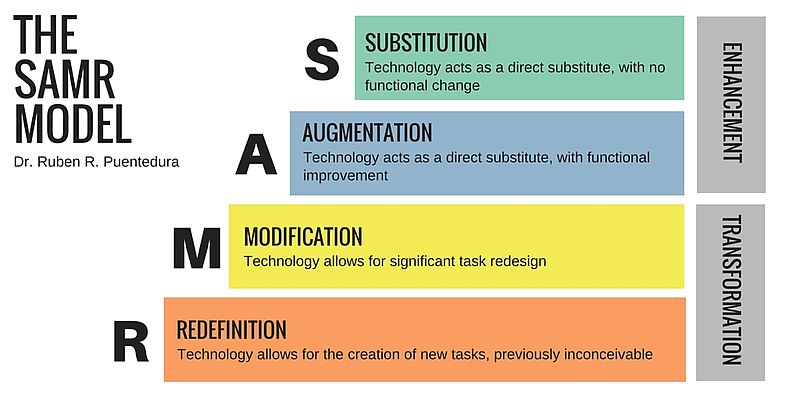Theoretical Frameworks
This learning module follows the TPACK (Technological Pedagogical Content Knowledge) model, Puentedura (2010), based on PCK (Pedagogical Content Knowledge), Schulman (1986, 1987). By integrating knowledge in content, technology and pedagogy, teachers like myself can use the TPACK model to use technology effectively. Awareness of the integration of content (EAL vocabulary, literacy and numeracy skills), pedagogy (understanding the needs of adult ESL literacy learners) and technology (using smart phones, a wiki and a personal computer in a lab), can improve teaching.
The SAMR (Substitution Augmentation Modification Redefinition) model (Puentedura, 2010) describes four formative steps teachers go through as we become proficient in the blended experience. The use of technology in this project aligns with the Augmentation step where technology acts as a tool substitute with functional improvements. In the past, normal cameras could have been used to take photos of signs, but mobile phone cameras allow learners to photograph, share and view instantly. A wiki can be used instead of bulletin boards to interact with the photos in various ways. Using personal technology allows learners to move independently, choosing what to focus on and how quickly. With a thoughtful approach such as reflection on the above frameworks, teachers can integrate technology into lessons in ways that allow for engaged, purposeful learning.

figure 1. TPACK Model (TPACK Model, 2012)
Reproduced by permission of the publisher, © 2012 by tpack.org)

figure 2. The SAMR Model (Lefflerd, 2016)
Technology Tools
This learning module makes use of three technological tools, a smart phone camera, a wiki and a personal computer in a computer lab. For learners who do not have smart phones, ipads will be given to use. Free wifi is provided in the school, to allow sharing of learner photos with their instructor. Empirical data revealed the overall effect of using mobile devices in education is better than when using desktop computers or not using mobile devices as an intervention (Sung, Chang, & Liu, 2016). In addition, regarding using the Internet, LaCava (2002) states this has a very positive effect on English language acquisition while it also provides opportunities for learners to interact and develop proficiency in technology skills. Learners can also access the wiki page from their mobile devices after having practiced on personal computers in the computer lab.
Adult Learning and Technology
Knowles (1984) has developed a model of adult learning which states the following:
1. As a person matures, his or her self-concept moves from that of a dependent personality toward one of a self-directing human being.
2. An adult accumulates a growing reservoir of experience which is a rich resource for learning.
3. The readiness of an adult to learn is closely related to the developmental tasks of his or her social role.
4. There is a change in time perspective as people mature—from future application of knowledge to immediacy of application. Thus, an adult is more problem centered than subject centered in learning. [Knowles, 1980, pp. 44-45]
In later publications, Knowles also referred to a fifth and a sixth assumption:
5. The most potent motivations are internal rather than external (Knowles et al., 1984, p. 12).
6. Adults need to know why they need to learn something (Knowles, 1984).
With adult learning needs in mind, using a mobile device and a personal computer for learning skills for immediate use in society can appeal to an adult learner's need for self-directed, immediate, problem-centered learning.
The Jarvis Learning Process (2006) states that at the start of the adult learning process is a disjuncture between biography, all that a person is at the time, and experience, an incident that a person is unprepared to handle. “Disjuncture occurs when our biographical repertoire is no longer sufficient to cope automatically with our situation so that our unthinking harmony with our world is disturbed to some degree or other” (2006, p. 9). Norton (2000) echoes this change by discussing how adult ESL learners create new identities when learning a new language in a new place (2000). Thieves & Turner (2011) found that ESL learners themselves viewed learning about computer a necessity.
Thus, adult ESL learners see learning about technology as necessary and many will have to re-imagine themselves as users of technology for the first time, or in new ways. Technology is rapidly changing with today’s innovations becoming quickly outdated; however, teachers and students must begin with current technology and continue to build upon their knowledge as technological advances unfold (Nisbet & Austin, 2013).
Comments (0)
You don't have permission to comment on this page.